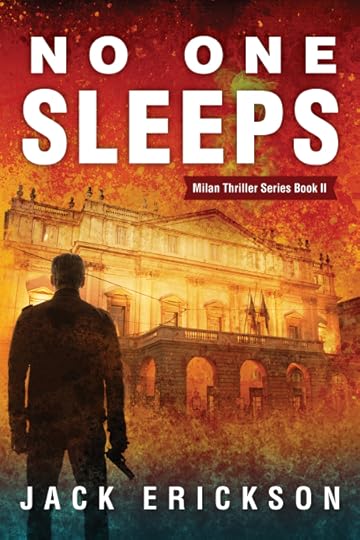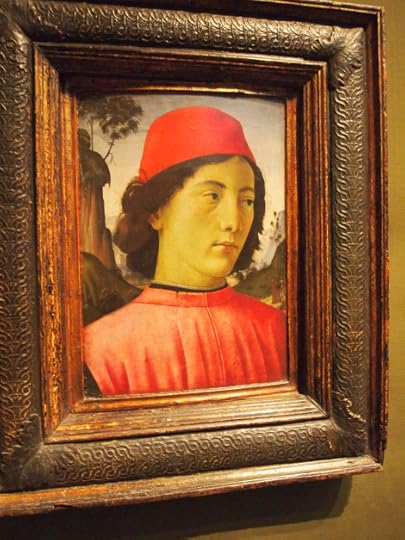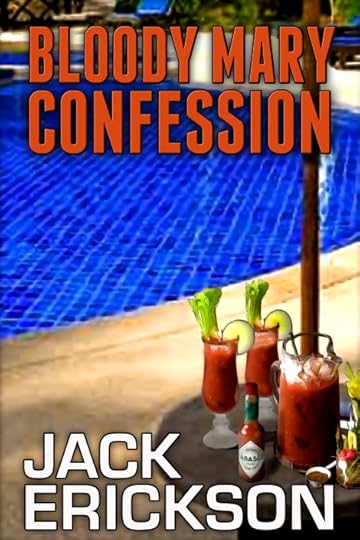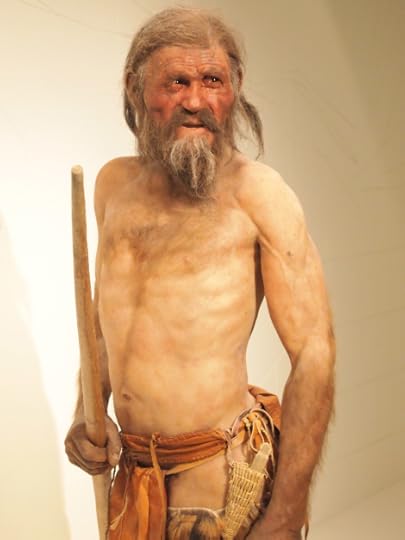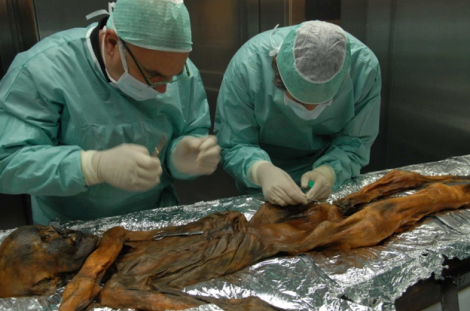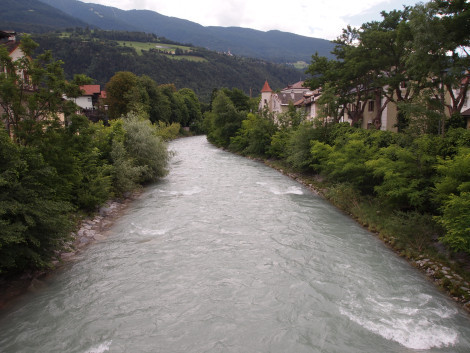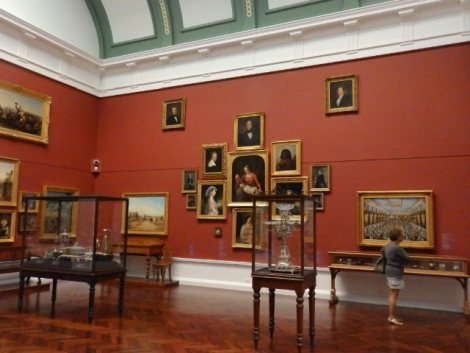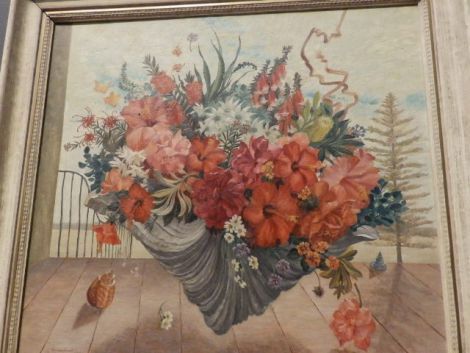Jack Erickson's Blog, page 2
September 16, 2016
No One Sleeps
NO ONE SLEEPS
I’m excited to announce the publication of No One Sleeps, the sequel to Thirteen Days in Milan.
I’ve been working on No One Sleeps for more than two years, a long time, but it involved research into many areas that were new for me. I’m fortunate to have the resources of a researcher, translators, sources, and friends in Milano who helped me along the way.
The title of the new book in Italian is Nessun Dorma. If you know anything about opera, you’ll understand the significance of the title.
Here is a blurb of the book:
Milan’s elite anti-terrorism DIGOS police receive a tip that a sleeper cell of Muslim terrorists have received toxic chemicals from Pakistan to make deadly sarin gas. The terrorist leader has access to Milan’s centers of finance, technology, commerce, and entertainment — all high-profile targets with hundreds of casualties in a terrorist attack.
No One Sleeps publication date is December 7, 2016. You can pre-order the e-book at a discount on digital sites and receive it on the publication date.
I’ll publish selected scenes from the book in future posts.
* * * * *
The first book in my Milan thriller series, Thirteen Days in Milan, is available as a paperback at bookstores and Amazon and as an e-book at the Apple iBookstore, Barnes and Noble, Kobo, Amazon, Smashwords and other digital sites.
Please share these links with writers or readers who might be interested.
http://www.jackerickson.com
Find my books in Apple’s iBookstore
At Barnes & Noble
At Amazon including # 1 Kindle best seller “Perfect Crime”
View my Smashwords profile:
Twitter: @JackLErickson


February 1, 2016
Etruscan Tombs

Fresco of Etruscan woman in Tarquinia tomb
Etruria – the Etruscan people of central Italy
Before Rome became an empire, central Italy was dominated by the Etruscan people who lived in present day Tuscany, Umbria, and Lazio. The name Tuscany (Toscano) is derived from Etruria.
Etruscans evolved from the Villanovan people around the 9th century BC when Rome was a village on the Tiber River. Etruscan kings ruled for a period from Rome until 509 B.C. They spoke their own language with roots from ancient Greece and Asia Minor.
Etruscans lived predominantly in walled towns on hills between the Apennine mountains running down the spine of Italy and the Tyrrhenian Sea to the west. They prospered, spreading north to the Po River Valley and south to Rome, successful in agriculture, mining copper and iron, making weapons, and trading with Greece and Carthage. Their abundant life allowed crafts to emerge so artists could learn to paint, sculpt, make jewelry, and design clothes.
What Etruscan Left Behind

Banquet fresco and burial vault
Historians and archeologists have been intrigued by Etruscans from the abundant artifacts they left behind in underground tombs — vases, pottery, statues, sarcophagi, jewelry, coins, and frescoes. Other than these artifacts, little is known about Etruscan history, religion, or philosophy other than inscriptions in their tombs.
Artifacts from some 6000 tombs indicate that there was a hierarchy of wealthy landowners merchants, and traders who lived well and exhibited their status with ostentatious displays in their tombs.
Tarquinia

Stone wall around ancient Etruscan town of Tarquinia
Twenty Etruscan tombs have been excavated, restored and are accessible for viewing outside the walls of the medieval town of Tarquinia 95 kilometers northeast of Rome. Tarquinia was one of the principal cities of Etruria located on a ridge of hills overlooking the Tyrrhenian Sea. High stone walls still encircle the town; vehicles and pedestrians enter Tarquinia through arched gateways in the ancient walls. The narrow, winding streets of Tarquinia are stone bricks polished black and worn smooth by centuries of wear.
Etruscan Necropolis

Etruscan sarcophagi in Tarquinian National Museum
Etruscan tombs honeycomb the hillside of Monterozzi outside Tarquinia. After the necropolis was discovered and excavated, modest cement structures were constructed over them with tiled roofs and a small entrance.
Watch your step!

Hang onto the railing – those steps are steep!

Steep steps climbing up
Viewing the tombs involves climbing down steep stone and metal stairs to a confined spot about 20 feet below ground. Tombs are protected somewhat from the elements behind glass windows and metal doors. Press a button, a light shines on the tomb’s interior for a few moments.

Cement structure over Etruscan tombs
Researchers have determined that the tombs were constructed for aristocratic Etruscan families who had the financial means to build the tombs and pay artists to decorate them. Archeologists discovered colorful frescos, funeral slabs and sarcophagi, jewelry, clothing, and ornaments to take into the next life.

Etruscan weapons
In numerous tombs, false doors were painted on the walls, possibly indicating the passage into the next world. Some tombs have been given name from distinctive features in the frescoes: Tomb of the Bull, Tomb of the Leopards.
Etruscan Banquets

Tomb of the Leopards
Etruscans weren’t shy about celebrating their rich and hedonistic lives. Frescos portray family members and friends seated at banquet tables being entertained by dancers, musicians, athletes, and exotic animals — panthers, lions, bulls, and horses. Restoration preserved some frescos which have faded over the centuries. The predominant colors are pastels of orange, green, yellow, and blue.
Early tombs dating from around 500 BC show Etruscans celebrating the joys of life with little reference to religion. Around 250 BC, frescoes included Greek and Roman gods influenced by Roman influence.
The decline of Etruscan civilization began in the 4th century after Roman armies sacked the Etruscan town of Velii in 396 BC. Within a hundred years, the Roman empire had spread across central Italy and the Etruscan people melded into Roman society. By 100 AD, the Etruscan language had virtually disappeared.

Tomb of the Lions
Tarquinian National Museum

Etruscan vase in early Grecian style
The Tarquinian National museum in the renaissance style Palazzo Vitelleschi in Tarquinia exhibits Etruscan art recovered from tombs, principally sarcophagi, colorful plates and vases celebrating mythological life, eroticism, sport, hunting, or battle.

Erotic scene on Etruscan pottery
After death, sarcophagi were placed in tombs on stone slabs or benches. When the tombs were discovered and excavated, the sarcophagi were removed to study human remains as well as the objects left in the tombs.

Etruscan pottery

Etruscan jewelry recovered from tomb
The museum displays Etruscan sarcophagi carved from white terracotta stone. On many sarcophagi, deceased life-sized human figures recline on their side, posing with a goblet of wine, scrolls, or another object. The figures most likely represent husbands and wives of wealthy families. Many sarcophagi are adorned with scenes of celebration, sport, and hunting.
* * * *
Next: Via Veneto
We’re been in Roma this winter, studying Italian, visiting historical sites, and researching a new book in my Milan thriller series.
The sequel to Thirteen Days in Milan will be published in a few months and available as a pre-sale in March. I’ll be posting a cover and description soon. The English edition and Italian translation, Tredici Giorno a Milano, are available as ebooks (Thirteen Days in Milan also in paperback) at the Apple iBookstore, Barnes and Noble, Amazon, Smashwords, and other digital sites.
The title of the sequel, No One Sleeps (Nessun Dorma in Italian), is a reference to the famous aria from Giacomo Puccini’s opera Turandot. The climax of No One Sleeps takes place at Milan’s La Scala Opera House during the season’s premiere held every December 7. The performance is broadcast live to millions of Italians.
Please share these links with writers or readers who might be interested.
Find my books in Apple’s iBookstore
At Barnes & Noble
At Amazon including # 1 Kindle best seller “Perfect Crime”
Twitter: @JackLErickson


February 8, 2015
Oxford, Oxfordshire UK
Oxford
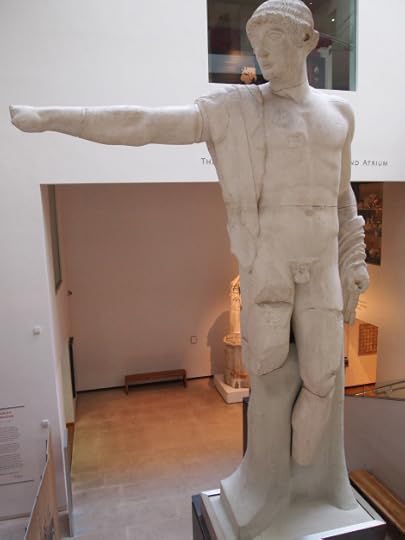
“Morse’s pub is across the street in the Randolph Hotel,” said the Greek warrior statue in Ashmolean Museum.
Oxford in the Thames River Valley is just two hours from London. ��The town draws more than 9 million visitors a year, and for good reasons. ��Who wouldn’t be inspired by the spires of the 34 colleges (Kings, Jesus, Balliol, Magdelan, Brasenose, Christ Church, Hertford, Merton) that comprise Oxford University which attracts scholars from around the world.
More than 8000 students have been chosen to become Rhodes scholars at Oxford, established by the trust of Cecil Rhodes in 1902.
We spent our first days in Oxford as we began our 2015 winter travel to Britain and France. ��We’d been to Oxford before, but wanted to return since Oxford is easy to navigate and the location of many cultural and historic sites.

Martyrs Memorial
The morning we arrived, we dropped luggage at our Abingdon Road guest house, hopped back on a bus and returned to Carfax Tower, the junction of four major streets: Cornmarket, Queen, High, and St. Aldate. ��From this intersection, you can reach most of Oxford’s colleges, churches, museums, libraries, bookstores and monuments.
Our first ‘cultural’ visit was to the world-famous Bodleian library.
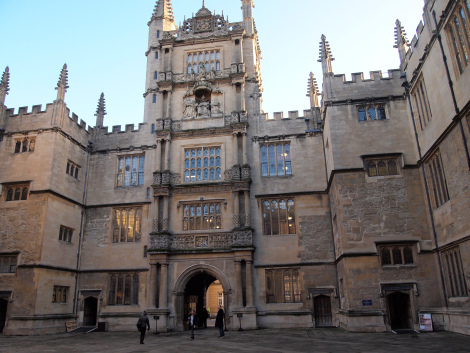
Bodleian Library courtyard
��Bodleian Library

Entrance to Bodleian Library
The Bodleian Library contains manuscripts and documents collected over the last 400 years. ��Duke Humpreys, Duke of Hampshire, brother of Henry V, donated a collection of manuscripts to Oxford in 1602. ��At the time, Oxford did not have a library. An agreement was signed in 1610 to provide a copy of each book published in England to the Bodleian which now has more than 3 million books.
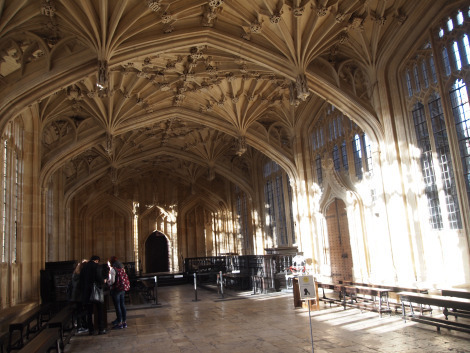
Tours of the Bodleian begin at the former Divinity School. After an orientation lecture, visitors walk up stone circular steps to the Humphrey Library.
The second floor of the Bodleian is the Humphrey Library, closed to the public, but open for scholars researching medieval history.
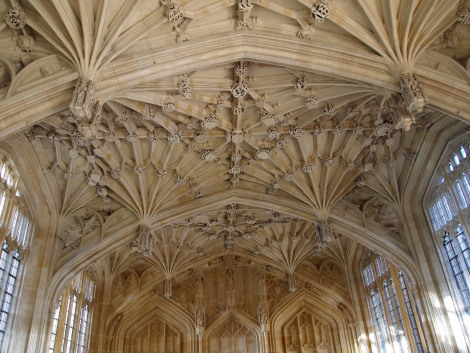
Vaulted ceiling, miniature sculpture figures of medieval characters at junctions.
The library has gone through many expansions over the last four centuries, including the Radcliffe Camera, a donation by Sir Michael Radcliffe, former student, physician, and personal physician to Queen Anne. ��Radcliffe also donated funds for an infirmary and observatory in Oxford.
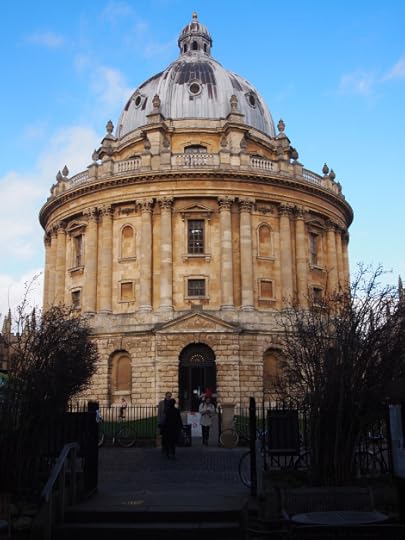
Radcliffe Camera, built in 1749, now part of Bodleian Library.
A short walk from the Bodleian library is Oxford’s most famous museum, the Ashmolean, also founded by a former 17th century Oxford scholar
Ashmolean Museum
Ashmolean Museum is Britain���s oldest university museum, a gift from Elias Ashmole who provided the first documents in 1667. The Ashmolean collection stretches from Roman artifacts to Italian Renaissance, ��French Impressionists, and collections gathered from travelers and scholars to Asia, the South Pacific, and Europe. The collection includes works by Michelangelo, Raphael, da Vinci, Picasso, Titian, and Cezanne.

French tapestry of South American jungle animals
Today the Ashmolean presents a variety of cultural activities including concerts, lectures, special exhibits, and speakers. ��A featured exhibition at the Ashmolean opening in March of the British painter and printmaker,��William Blake.
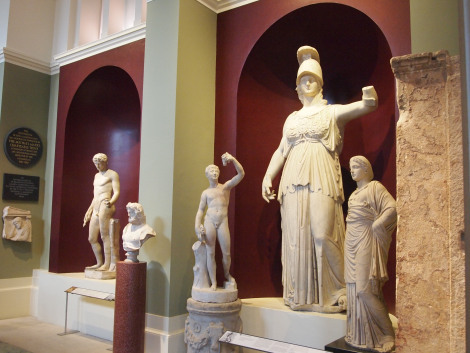
Statuary hall in Ashmolean Museum

18th century Flemish still life
Contemporary Oxford��
Oxford isn’t only about preserving the past in books, art, architecture, and religious life. ��It also has a popular appeal as a setting for movies and TV shows, especially the BBC mystery series Inspector Morse, Inspector Lewis, and the latest, Endeavour, about Morses’ early years in the Thames Valley police force.
Walking along High street or in the courtyard of Christ Church, you expect to see John Thaw (Morse), Kevin Whately (Lewis), or Sergeant James Hathaway.
Randolph Hotel – Morse’s pub
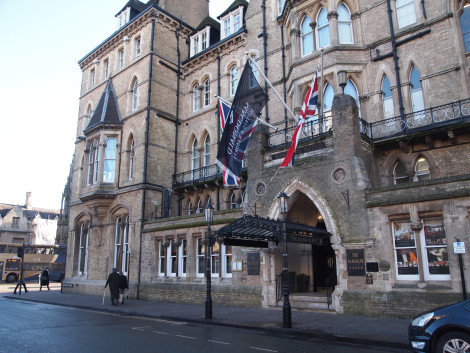
Randolph Hotel across from the Ashmolean Museum on Beaumont Street
Across from the Ashmolean on Beaumont Street is the stately Randolph Hotel. The Randolph’s pub is now known as Morse’s pub since several episodes of Inspector Morse were filmed here from 1987 to 2000. ��A plaque in the pub acknowledges the place where Inspector More and Detective Lewis discussed the intricacies of their murder cases over a pint or two of ale.
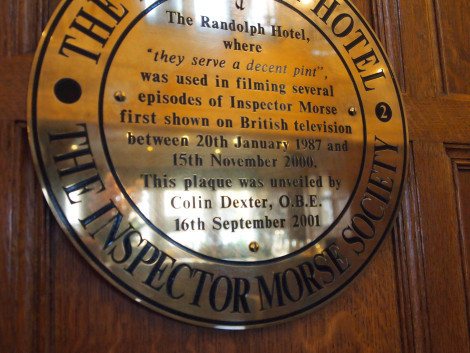
Morse, “They serve a decent pint here.”
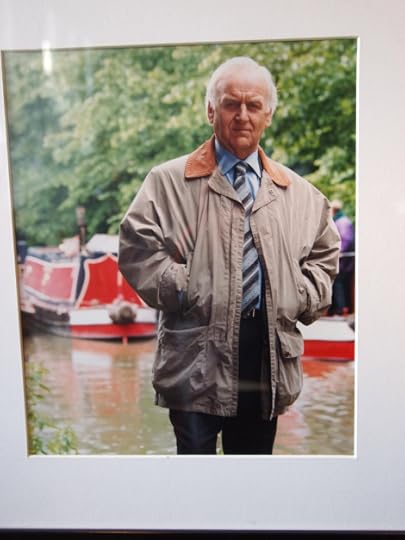
John Thaw
Of course, we had to have a pint and sit in front of the fireplace where Morse and Lewis had debated the intricacies of the murders they were trying to solve (they always did, often with convoluted twists that only brainy Morse could unravel).
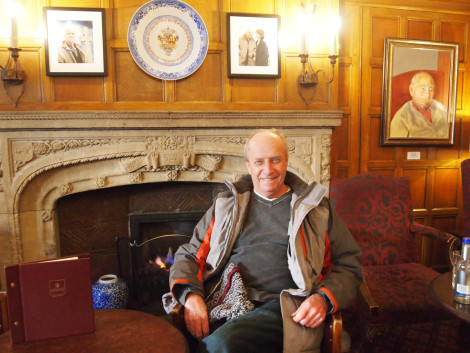
Morse and Lewis unraveled the mysteries of Oxford here. Over a pint or two.
We bought a guide-book and CD of the Morse and Lewis series. ��Walking around Oxford, we found several locations where scenes from the series were filmed. ��One was the Kings Arms pub. ��During our visit, we noticed many Oxford MBA students celebrating passing their first tests.
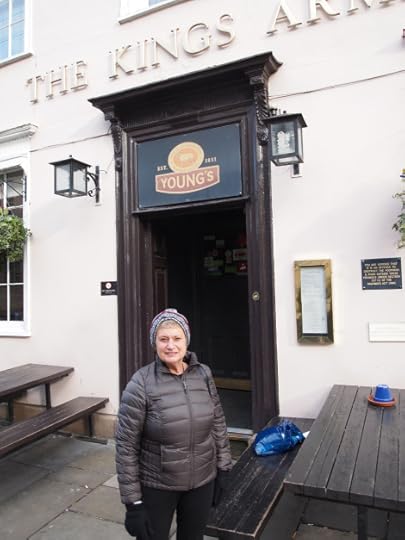
Kings Arms, another favorite pub of Morse and Lewis
Over lunch of fish and ships and a pint of ale, we talked to students from the UK, US, New Zealand, and Australia. ��All were loving their year at Oxford. ��Don’t blame them.
The grad students said there was an old Oxford tradition that students don formal wear: ��black robes, starched shirt, and white tie for a formal ceremony celebrating passing their first exams. ��But they have to carry mortar boards, which they may wear at graduation in the summer.
We loved celebrating with them.
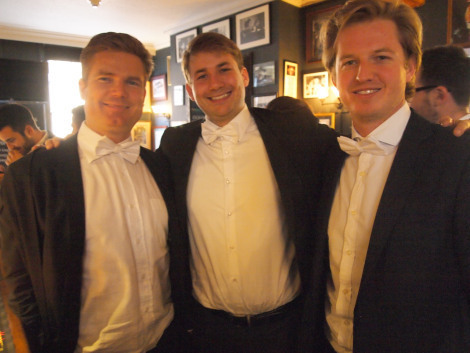
A Yank, Kiwi, and Aussie celebrating at the Kings Arms

Oxford grad students celebrating passing their first tests in their MBA program
One evening, we attended Evensong at Christ Church, a candlelight evening service of adolescent boys wearing floor length white robes and scarlet vestments singing hymns a capella in Latin and Italian. ��Very inspirational.

Waiting for Morse and Lewis to share a pint with us.
* * * * *
Next: ��York in Yorkshire
We’re spending part of the winter in Britain and France, researching, visiting friends, and discovering new places to share with you.
My first international thriller, Thirteen Days in Milan, is now in paperback and also available as an ebook at the Apple iBookstore, Barnes and Noble, Amazon, Smashwords, and other digital sites.
I’m researching the sequel to “Thirteen Days” in Milan and planning to release an Italian version soon.
Please share these links with writers or readers who might be interested.
Find my books in Apple’s iBookstore
At Barnes & Noble
At Amazon including # 1 Kindle best seller “Perfect Crime”
View my Smashwords profile:
Twitter: Hoya73

December 10, 2014
Bloody Mary Confession
��Bloody Mary Confession
My first pre-sell novel, Bloody Mary Confession, will be published December 14 on all ereader sites. ��A pre-sell is a book that can be posted on-line for readers to sample and order. ��On publication day, their credit card is charged and they can read the entire book.
The ‘Story’ behind “The Story”
Bloody Mary Confession is really two stories. ��One is a novel of a contemporary American mystery.
The other story is how it evolved from a short story into a novel. ��Let me share that back story before I tell you the plot.
In the past, I have published short mysteries, all with a twist at the end ��(Perfect Crime, Missing Persons). Reviews on ebook sites were positive with many saying (paraphrasing here): “I wish this was longer, I wanted more.”
When I read those reviews, I wondered if I could have taken time and developed a short story into a novel. ��Maybe yes, maybe no, I’d never tried. ��Some ideas are meant to be short stories; others need a full-length novel to tell a more complex story.
Bloody Mary Confession started two years ago as a 7,500 word short story, edited, cover designed, a clever twist at the end, ready to go. ��But I didn’t publish it. ��I held back, wondering if I could turn it into a novel.
A year ago I expanded it to 20,000 words, novella length, then to 40,000 words adding new characters, subplots, and back stories. ��I revised it one more time this year and found places to punch it up with more intrigue, drama and character development. ��I devoted nearly three chapters, building up to the suspenseful climax when readers learn the meaning of Bloody Mary Confession.
Bloody Mary Confession is now over 60,000 words and ready to go. ��Readers will decide if the short story idea was substantial enough to become a novel.
The Plot��
Three college students, Max, Amanda, and Debra, meet and bond at a beer-soaked celebration after a victorious football game.
They graduate and begin exciting careers. ��Max is drafted by the Red Sox; he and Amanda marry and she becomes a Hollywood actress. ��Debra, a friend to both, becomes a corporate executive.
But through life’s twists and turns over the years, each faces challenges that test their characters. ��Max and Amanda, once America’s beautiful couple, divorce and go their separate ways. ��Deb climbs the corporate ladder, but never finds the right man. ��
Twenty years after they first met, a suspicious death — a possible murder — reunites them. ��Sort of. �� A dark secret emerges until a Bloody Mary Confession reveals all.
Writing is learned every day
Writing Bloody Mary Confession was a valuable learning experience. I was patient, taking time to take the germ of a story idea and discover techniques to give readers more — fully developed characters, relevant back stories, personal conflicts, and heightened drama. ��I hope you will like it!
��Where you can find Bloody Mary Confession
Bloody Mary Confession is available at all ebook sites: ��Apple’s iBooks, B&N Nook, Amazon, Kobo, and Smashwords where it is discounted 33%, just two bucks.��A real deal. Enter the code: LK23A
http://www.smashwords.com/books/view/…;
Reviews are welcome!
Find my books in Apple’s iBookstore
At Barnes & Noble
At Amazon including # 1 Kindle best seller “Perfect Crime”
View my Smashwords profile:
Twitter: Hoya73

August 5, 2014
Otzi the Iceman
Otzi the Sudtirol Iceman
A startling discover
In September, 1991, a German couple from Nuremberg were hiking across the Otzal alps on the border between Austria and Italy. Hiking at 3200 meters, they found a strange object partially exposed in glacial ice.
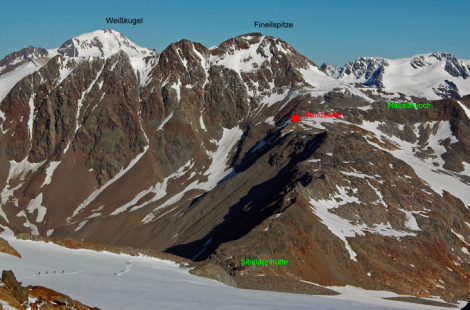
Otzal alps
They suspected it was the body of a mountaineer and trekked to a national park office to notify a ranger. They returned to the site the next day with the ranger who suspected it might be a missing mountaineer from long ago. The ranger notified the Austrian police who arrived later that day in a helicopter.
When the police studied the remains, they originally suspected a possible murder and that the victim had been stripped to prevent identification. Another theory was that the remains were those of an Italian soldier missing since the Great War. Word spread quickly in alpine communities and experienced hikers began arriving at the site.
Recovering the remains
A three-day excavation began, but bad weather, hard ice, and difficult terrain made it difficult to remove the body from the ice. Drills and axes were used and the remains were whisked off to the University of Innsbruck since it was thought that the site was in Austria. Police and hikers began recovering objects around the body which appeared to be remnants of clothing, tools, and primitive weapons.
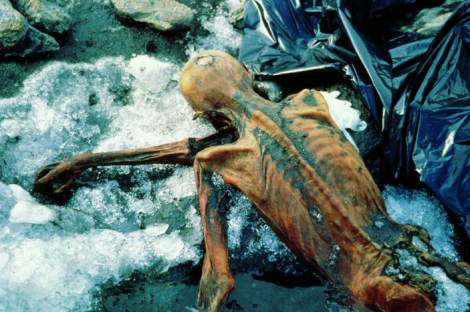
Otzi’s remains frozen in glacial ice
The first examinations were conducted at the University of Innsbruck. A survey of the site determined that the remains were less than 100 meters inside the Italian border. Italian authorities gave the Austrian authorities permission to continue research rather than risk moving the remains and possibly damaging scientific evidence.
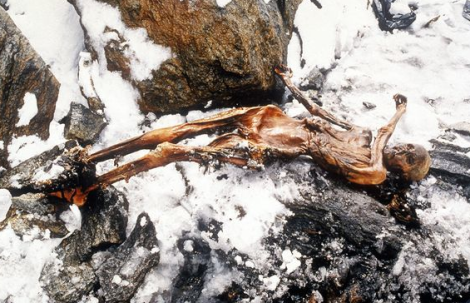
Otzi’s remains recovered from ice
A peak into Neolithic times
Scientists from around the world began a comprehensive investigation into the remains as well as artifacts recovered from the site with advanced scientific instruments including X-rays, CAT scans, MRI, and powerful microscopes. Because the remains were discovered in the Otzal alps, he was named Otzi.
What scientists discovered was a treasure of artifacts that allowed them to better understand daily life during the Neolithic era. Otzi’s body is the oldest mummy preserved from European history.
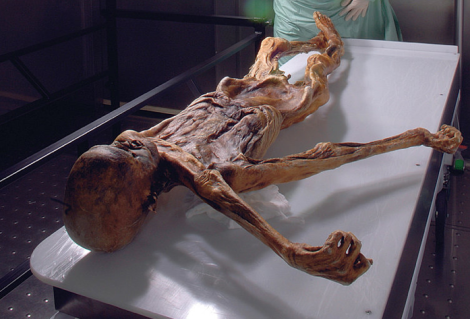
Otzi in laboratory
Research determined that Otzi was about 45 years old when he died around 3500 BC.
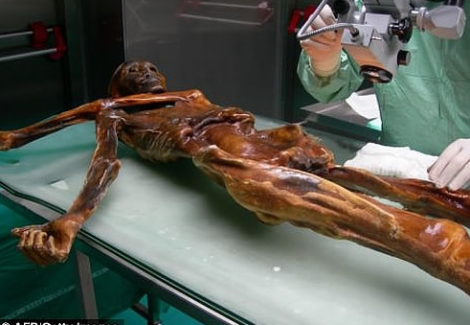
Naturally preserved Otzi
One puzzling feature of Otzi’s body were some fifty tattoos on his legs and feet. Forensic pathologists believed they were evidence of primitive medical treatment similar to acupuncture. Crude incisions were made in his skin near joints and then smeared in charcoal.
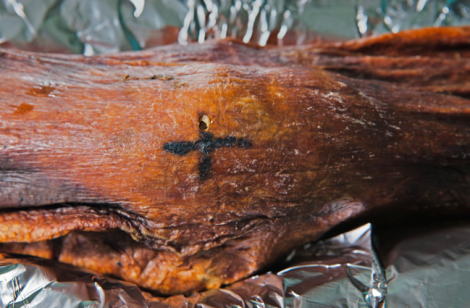
Tatto on Otzi’s leg
A sick old man
Decades of research allowed scientists to determine the state of Otzi’s health, his illnesses, and possible involvement in forging copper. The state of Otzi’s health was not good; he had parasitic worms in his gut, heart disease, diseased joints, and high level of arsenic possibly linked to his work forging copper to make weapons and tools.
PBS presented a documentary about the forensic science that examined minute bits in Otzi’s transverse colon which turned out to be parasitic worms as well as fragments of his last meal. Otzi had eaten about eight hours before he died. His last meal included ibex meat, a bread made from einkorn, barley seeds and berries from native trees.
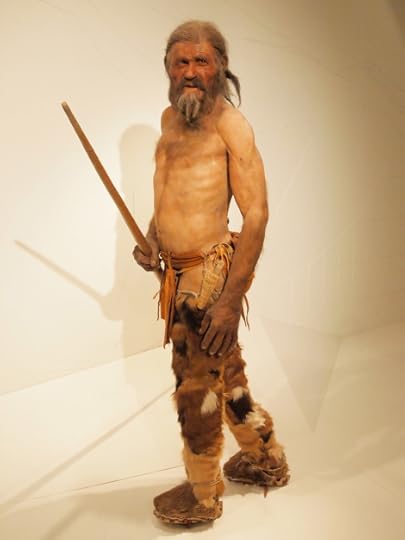
Otzi, rugged and lean, but hard muscled from lifetime of hiking in the alps
Things Otzi carried with him
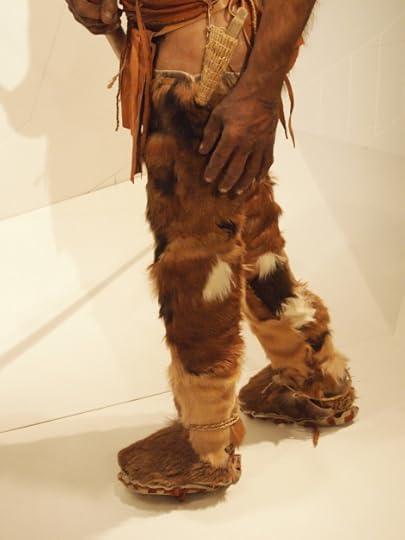
Otzi’s leggings, shoes, and sheathed flint knife
On Otzi last hike across the alps, he wore leggings sewn from goat leather of two colors; shoes made from bear fur, a fur cap, a blouse made from goat leather, and a twine belt.
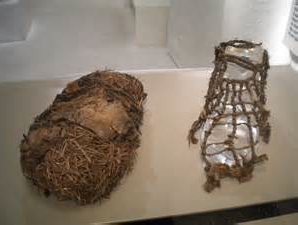
Otzi’s bear fur shoes bound in twine
Otzi was carrying tools and weapons on his last hike; a forged copper axe, a long wooden shaft that was probably being made into a bow, and twelve arrow shafts in a goat leather quiver. Two arrows had flint arrowheads, the others were shafts that had not been finished making into arrows. Otzi was carrying flint and material in his quiver to finish more arrows.
Otzi also carried a flint knife with a yew handle kept in a sheath made from grass.

Otzi’s goat skin quiver and arrow shafts
Centuries old Unsolved murder
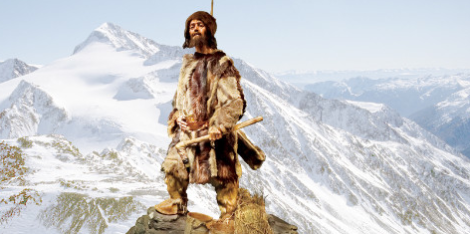
How Otzi might have appeared on his last hike across the alps 5500 years ago
Recent forensic evidence convinced scientists that Otzi met a grizzly ending on his last journey. He was attacked on an alpine path about two hours after his last meal of ibex, roots, and grain. One or more of his attackers shot him in the back with an arrow, clubbed the back of his head, and stabbed him in the chest. He died from the blow to his head.
Otzi’s body was frozen within hours, possibly by heavy snowfall which turned to glacial ice and preserved his body for more than fifty centuries.
Preserving Otzi for the world
Otzi’s final resting place is at the Sudtirol Archeological Museum in Bolzano. The discovery of Otzi was so significant, the Sudtirol government built the museum just for him.
And a fascinating museum it is with photos and videos of the excavation, exhibits on scientific research from Otzi’s tools, weapons, and clothing.
Two exhibits in the museum are stunning; shortly after entering the museum, viewers can step onto a platform in a darkened room and look through glass at Otzi’s body preserved in an ice box, lying on a gurney, under bright lights, naked for the world to see. Otzi’s muscles have atrophied, but he looks like he’s asleep, one arm stretched across his chin like he had fallen onto rocks after being struck on the back of his head.
At the end of the exhibition artists have made a life-sized model of Otzi, bare-chested and alert, as he might have appeared in his last years.

Model of Otzi the Sudtirol Iceman
Photos from Sudtirol Archeological Museum
* * * * *
Next: Leipzig and Johann Sebastian Bac


July 18, 2014
Brixen / Bressanone, Sudtirol
Brixen / Bressanone
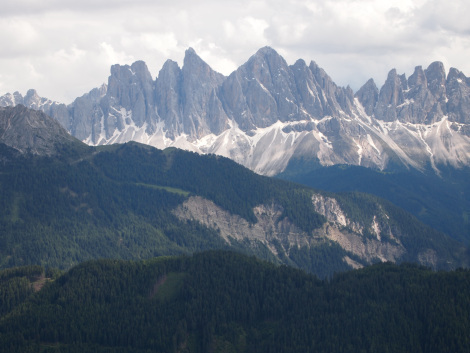
Dolomites in Sudtirol
The Sudtirol area of northern Italy was once part of the Austro-Hungarian empire, ruled by the Hapsburgs for 300 years. The 1919 Treaty of Saint-Germain-en-Laye ended the Austro-Hungarian empire and ceded Sudtirol to Italy as war booty to compensate Italy for the tremendous losses Italian troops who died during the Great War. One of the bloodiest battlefields outside from the Western front were in Austrian alps and Dolomites where more than 750,000 Italian troops died.
Sudtirol is also known as Alto Adige for the Adige river which runs swiftly north to south through the steep valley toward Verona. The valley is lush from heavy rain and snow fall, and vineyards stretch along the hillsides for miles. The steep granite mountains, the Dolomites, are popular in the summer with hikers and in winters for skiers.
The principal town in Sudtirol is Brixen (German) or Bressanone (Italian). The Eisack and Reinz rivers meet in town where a major flood control project is underway to limit spring flooding which has left the city underwater for centuries.

Dolomites from Val Croce
Gasthaus Majestic
Our lodgings were at a charming gasthaus 2 kilometers up the hillside from Bressanone. We had spent a few days in an apartment in center of Bologna, busy traffic, crowded streets, and a bit shabby with graffiti everywhere. The Gasthaus Majestic Lucy found online turned out to be the opposite of how we lived in Bologna.
We had a spacious and very modern apartment with kitchen, living room, bedroom, full bathroom with a washing machine! And a balcony to sip tea and coffee before going down to breakfast. After a busy day touring Sudtirol, we came back every night to enjoy a glass of wine on our balcony, marvel at the view of snow-capped alps in the distance and the sound of a rushing creek below.
We stayed a week. Enjoyed every minute of it.
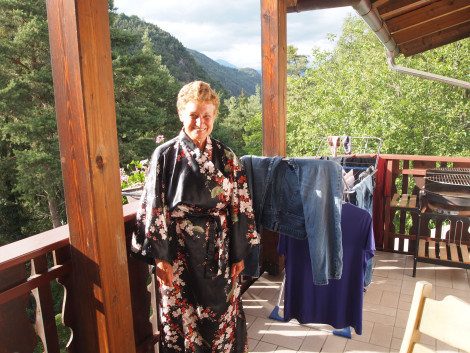
Travel buddy, good cook, occasional laundress, hanging wet clothes to dry in the morning sun.
The Majestic provided us with two Brixen cards when we arrived, a nifty and efficient way for tourists to get around the area without paying bus and museum fees. We used our Brixen cards three or four times a day, saving money, hopping on and off buses, getting into museums, traveling where we wanted using Brixen’s efficient public transportation.
If only the US had such efficient and modern public transportation in rural areas.
Plose to Val Croce
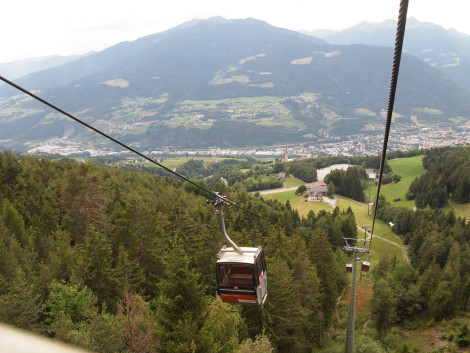
Cable car from Plose to Val Croce above Bresannone
Our Brixen cards allowed us to take a bus to Plose along winding hillside roads above Bressanone, then board a cable car to Val Croce, a 6000 foot high plateau with spectacular views of the Dolomites, numerous hiking trails, and lush pastures where dairy cattle were grazing, bells clanging, munching grass, and drinking from streams of fresh mountain water.
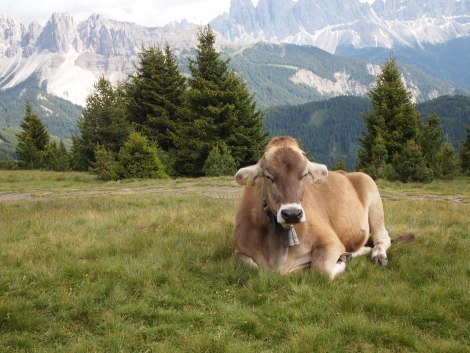
Even dairy cattle enjoy alpine views while grazing
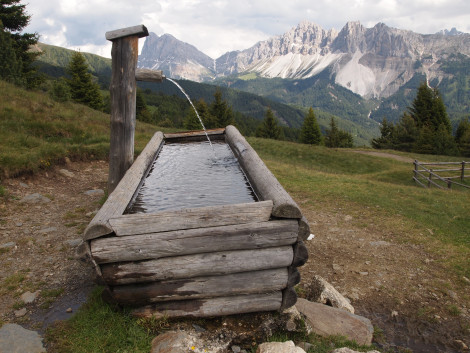
Along hiking trail in Val Croce

Happy wife on the trail
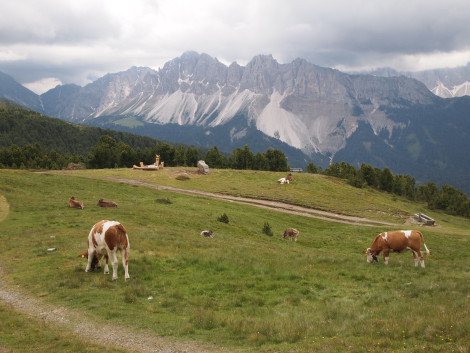
Contented cows make the best milk and cheese

Nice to take a break on a handmade wooden bench with a view of the Dolomites.
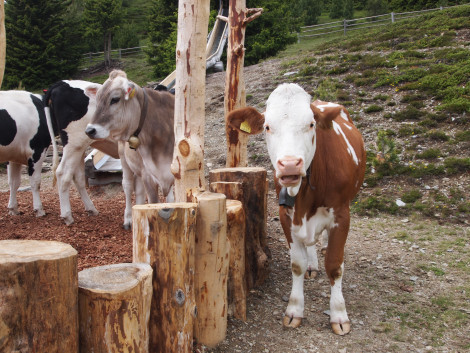
Who you looking at?
Bressanone

Hiking into Bressanonne looking over Reinz river
We walked through Bressanone daily for sight-seeing, grabbing lunch and a glass of wine, or boarding a bus to travel to nearby villages. One Sunday, when buses weren’t running regularly, we hiked into town, down steep trails, passing terraced vineyards, crossing bridges until we reached Bressanone.
Along the way, we had nice views of town and the Reinz river.
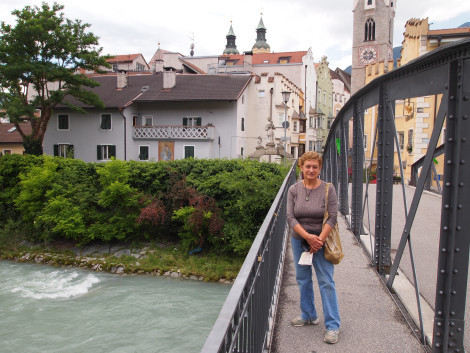
Crossing bridge into Bressanone after Sunday morning hike
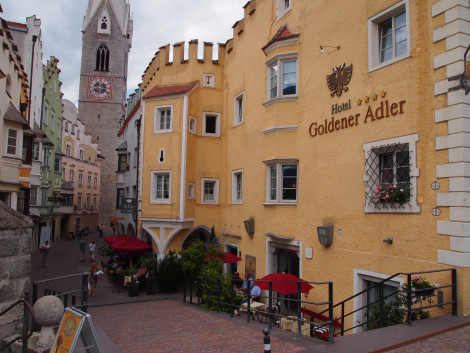
Into the historic center of Bressanone
Vipetino
Our travels around Sudtirol including visits to Luson, Vipetino, and Saint Ullrich, all charming alpine villages, scenic, and worth seeing.
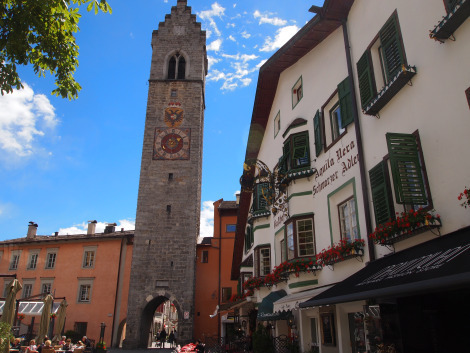
Vipetino
Vipetino is a mountain village near Brenner and the Austrian border. It took our bus from Brixen almost an hour driving along a rushing river, crossing bridges, pulling off at villages to pick up and drop off passengers.
When we arrived, we spent a couple of hours strolling along cobblestone streets, having lunch, and stopping in a few shops.
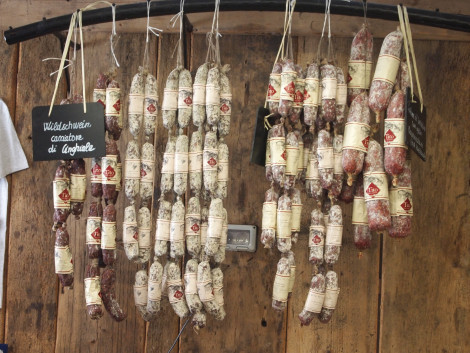
Sausages hanging in macelleria (butcher) selling cheeses, speciality meats, bacon, wine, breads and cookies. We bought cheese and bread to take back on our bus.

Free samples!
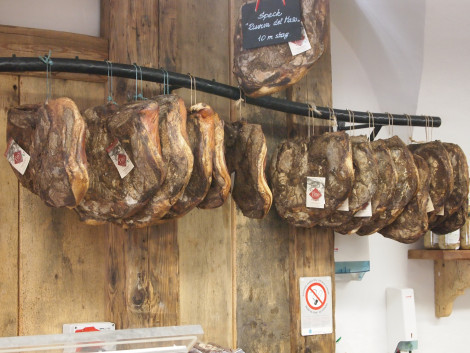
Fresh prosciutto ready for slicing

Wanted to buy this sign in a Vipetino shop; too bulky to travel with.
We traveled through Sudtirol last summer on a train from Munchen through Innsbruck to Trentino, about 60 kilometers south of Bressanone. We enjoyed that trip so much, we wanted to return, stay in another town, explore the majestic Dolomites, scenic alpine valleys and villages. I’m sure we’ll be back!

Nothing like crisp mountain air, hiking alpine trails, and hearing cow bells to put a smile on your face.
* * * *
Next: Otzi, the 5500 year old man
We’re back in Europe for the summer, researching, traveling, visiting friends, and discovering new places to share with you.
My first international thriller, Thirteen Days in Milan, is now in paperback and also available as an ebook at the Apple iBookstore, Barnes and Noble, Amazon, Smashwords, and other digital sites.
I’m researching the sequel to “Thirteen Days” in Milan and planning to release an Italian version soon.
Please share these links with writers or readers who might be interested.
http://www.jackerickson.com
Find my books in Apple’s iBookstore
At Barnes & Noble
At Amazon including # 1 Kindle best seller “Perfect Crime”
View my Smashwords profile
Twitter: Hoya73


Bologna
Bologna
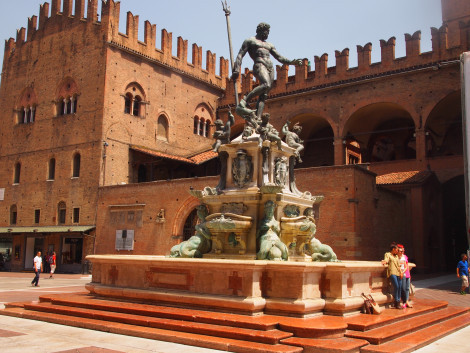
Fontana Nettuno (Neptune Fountain) in Piazza Maggiore
Because of its location in the Po River Valley near the Apennines, Bologna has been at the crossroads of European history since 1000 BC. Etruscans settled here, Rome colonized it, and began laying out a walled city with a grid of intersecting narrow streets that remain the historic center city.
Bologna is home of the University of Bologna, the first western university started in 1088. Dante, Boccaccio, and Petrarch were students as well as Guillermo Marconi, inventor of the telegraph, who was born in Bologna.
The University of Bologna attracts a large international student body, who are largely responsible for the ugly graffiti plastered on the city’s buildings including palaces and historic sites. A real blight, very unfortunate to have scars mar the beauty and architecture of a historic city.
Piazza Maggiore
Piazza Maggiore is the main square in Bologna, which is surrounded by St. Petronius Church, medieval palaces, and city hall. Fontana Nettuno (Neptune fountain) in the piazza has been a meeting place for centuries. Bologna has many fine museums of archeology, geology, modern art, medieval and church history. The city has its own civic art museum in city hall on Piazza Maggiore.
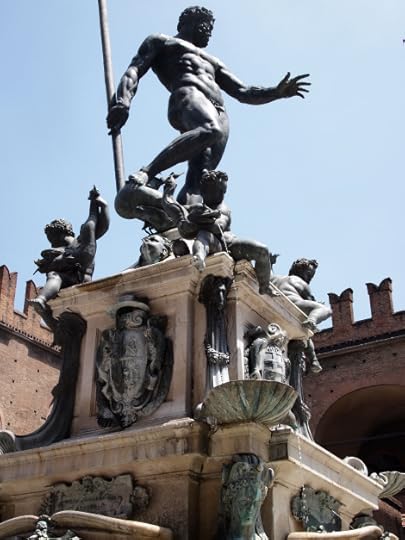
Nettuno fountain in Piazza Maggiore
City of towers and porticoes
Bologna is known for its extensive porticoes which are both artistic and practical, providing curved arches for paintings and mosaics and also providing sheltering pedestrians from inclement weather. We took advantage of Bologna’s porticoes which allowed us to navigate around the city when it was drizzling.
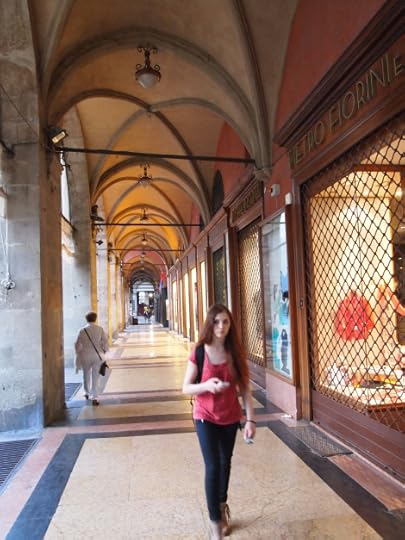
Portico in fashion district

Portico mosaic on Piazza Cavour
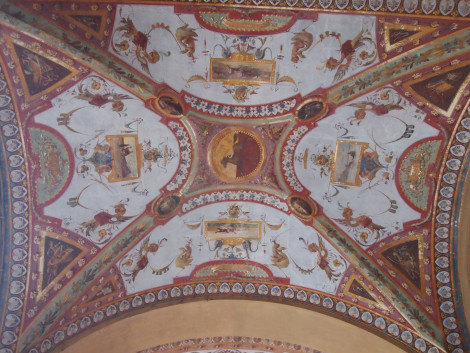
Portico mosaic on Piazza Cavour
Dueling towers
In the 12th and 13th centuries, noble Bolognese families built towers within the walled city as a sign of their wealth and stature, but also as a defense. More than medieval 180 towers were built, but only about 20 remain. One of the museums had a panorama of what Bologna looked like with towers dominated the landscape.
Two famous towers from earlier centuries, “Due Torre” have become a symbol of the city. The Asenilli and Garisenda towers are next to each other in front of the Santo Stefano church not far from Piazza Maggiore.
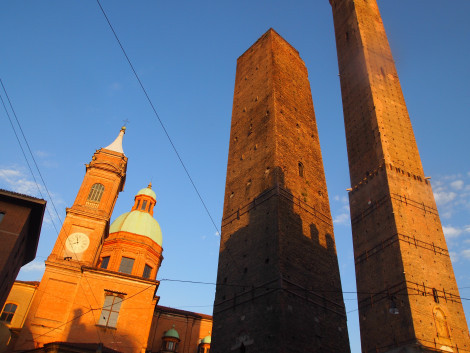
Dueling towers
Early in the construction of the Garisenda tower, builders discovered it had begun to lean. Construction was halted, but the tower, which had only reached 20 meters, was allowed to remain. That was respectful.
The Asinelli tower, which reaches nearly 200 meters, is the highest remaining medieval tower in Bologna and is visible for miles.
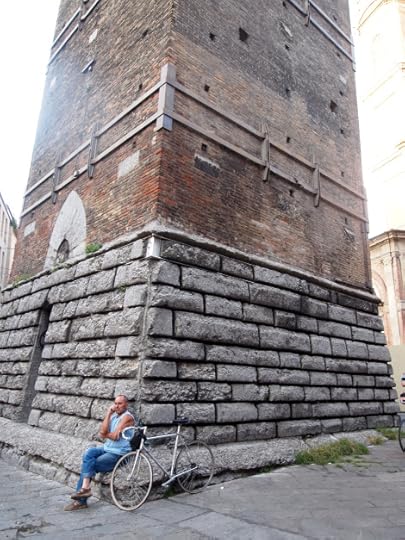
Base of leaning tower
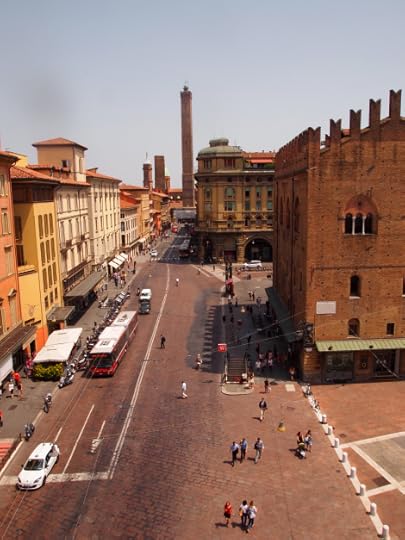
Due torre from Piazza Maggiore
Bologna train station bombing
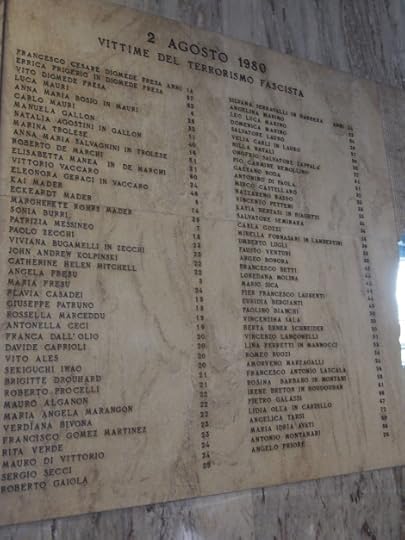
Plaque of 83 victims of 1980 train station bombing
Bologna was a booming center of industrialization after World War II and became a hotbed for communists and left-wing groups. During the 1960s – 1980’s, Italy was traumatized by radical right-wing fascists and left-wing terrorists such as Brigate Rosse (Red Brigades).
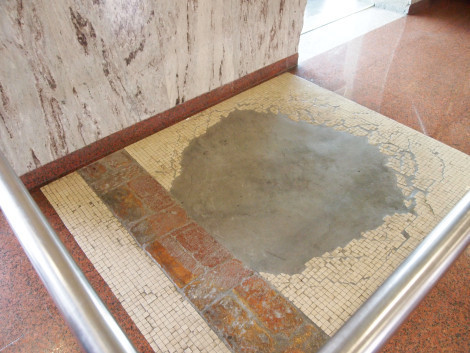
Site of bomb detonation
On August 2, 1980, a massive bomb exploded in the Bologna train station killing 83, injuring 200, and destroying the station. The bombing was carried out by fascists terrorists, many of whom were tried and convicted.
The city has memorialized the tragedy with a plaque listing the victims names. A hole in the tile floor where the bomb detonated has been filled with cement, and a blown-out door frame next to it has been restored.

Blown out door from bombing
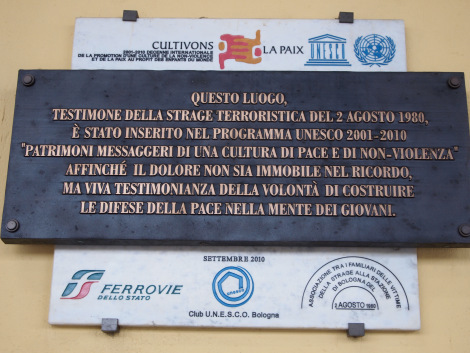
Plaque commemorating the tragedy of the terrorist bombing
The outside clock has been permanently stopped at the moment of the explosion: 10:24 AM. Black and white photos on a wall in the waiting room show the station before the bombing and the devastation caused by the bomb.
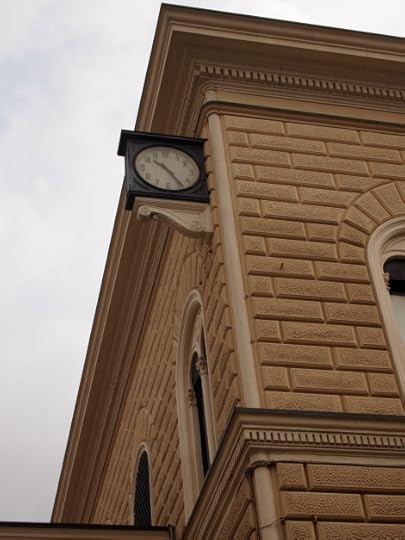
Train station clocked permanently stopped at time of explosion
On a bus tour one day around the city, we drove up a wooded hillside with beautiful villas, gardens, parks and a local hospital that was formerly a palace. Incredible views of the city, its red-tiled palaces, historic buildings, and towers.
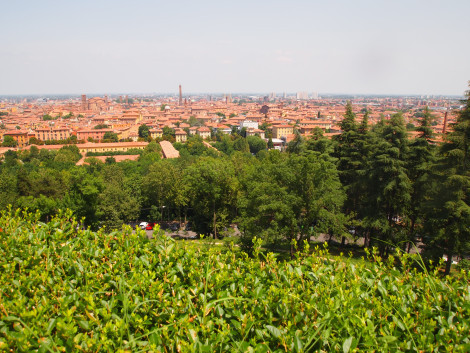
Bologna from foothills of the Apennines
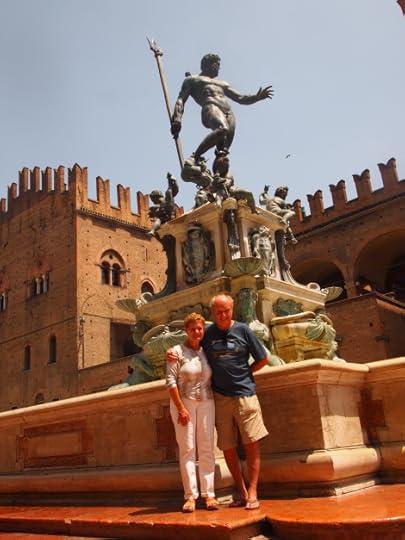
Last day in Bologna at Fontana Nettuno
* * * * *
Next: Bressanone / Brixen in Sudtirol
We’re back in Europe for the summer, researching, traveling, visiting friends, and discovering new places to share with you.
My first international thriller, Thirteen Days in Milan, is now in paperback and also available as an ebook at the Apple iBookstore, Barnes and Noble, Amazon, Smashwords, and other digital sites.
I’m researching the sequel to “Thirteen Days” in Milan and planning to release an Italian version soon.
Please share these links with writers or readers who might be interested.
www.jackerickson.com
Find my books in Apple’s iBookstore
At Barnes & Noble
At Amazon including # 1 Kindle best seller “Perfect Crime”
View my Smashwords profile
Twitter: Hoya73


February 19, 2014
Adelaide Walkabout
Adelaide Walkabout
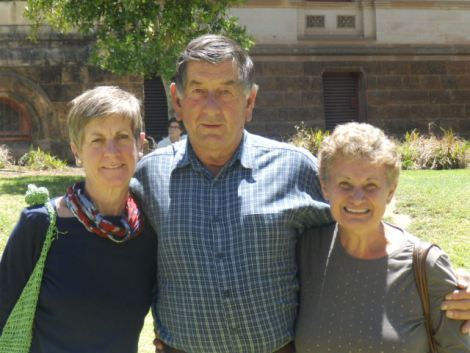
Sunny afternoon in Adelaide
South Australia had been suffering extreme heat through January causing bush fires throughout the state with some towns reaching record temperatures, 47 – 49 C ( 118 F). It was the kind of heat the smacked you in the face as when you walked out the door. All days weren’t as bad, but the heat affected what you’ll do that day.
On a day when there was a bit of break from the heat, we drove a half hour from the Adelaide Hills into Adelaide, the capital of South Australia. Adelaide is on the Fleurieu peninsula on the Southern Ocean.
Adelaide is an easy to navigate; the urban center is concentrated on a grid of four main streets that form a square. Inside the square all streets are parallel or intersect with the border streets. Confusing? Not really, it’s like the city was laid out by engineers tasked with coming up with the most logical and streamlined way to plan a city.
On the north end is the Torrens River and War Memorial drive, a popular place for families to relax and enjoy the views.
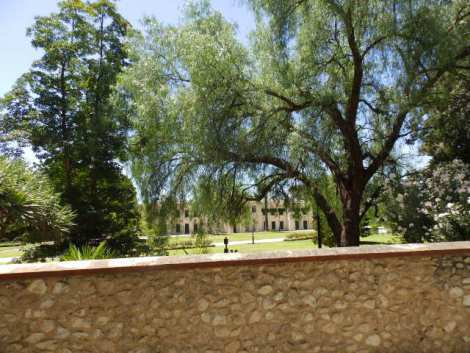
Governor General’s residence
We were most interested in the historic area along North Terrace which forms one of the boundaries of the city. Along North Terrace are Adelaide’s historical buildings: Old Parliament House, Parliament House, Government House, the ANZAC memorial, Science Museum, State Library, Art Gallery of South Australia, and campus of South Australia University.
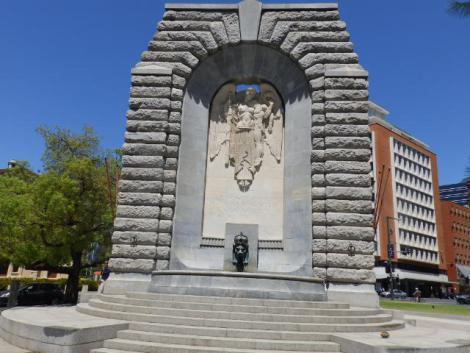
ANZAC Memorial
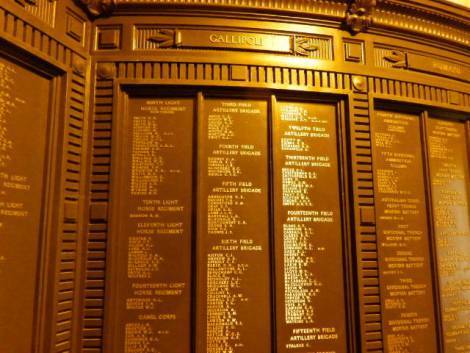
Gallipoli Memorial
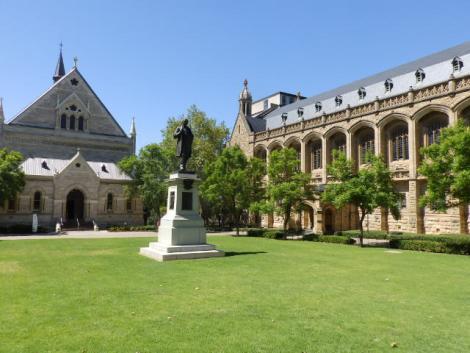
South Australia University
Walking along North Terrace is like taking a journey through the early history of Adelaide when it was settled by immigrants, many from Germany and the UK. Prisoner labor did a lot of the early infrastructure work, building roads and erecting buildings that have lasted more than 100 years.
Art Gallery of South Australia
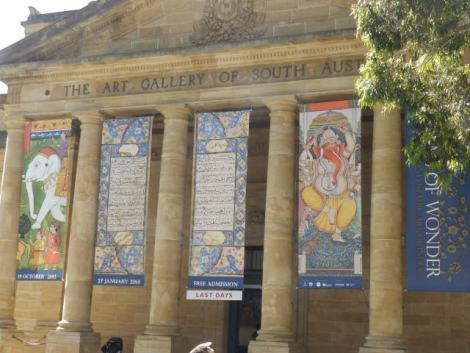
Art Gallery of South Australia
We ventured into the State Library, the Science Museum, but spent out most time in the Art Gallery which had an impressive collection works mostly from Australian artists Many paintings portrayed the history of the settlement of Australia and it’s diverse and colorful landscapes.
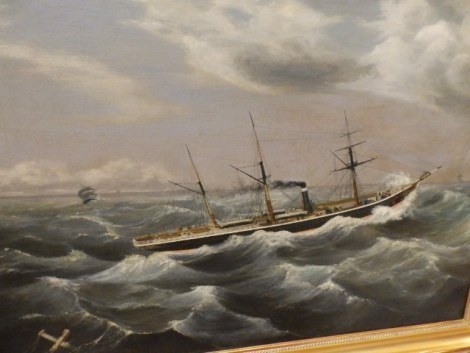
One of many ship disasters in Australian history
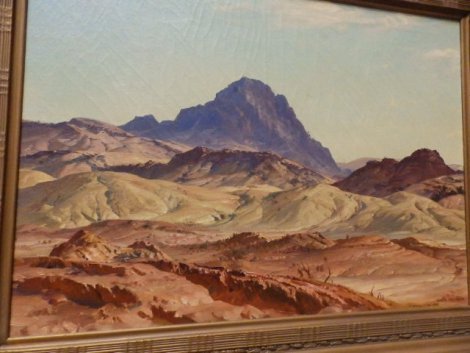
Australian landscape
Many works were modern, like you’d find in American or European galleries or museums.
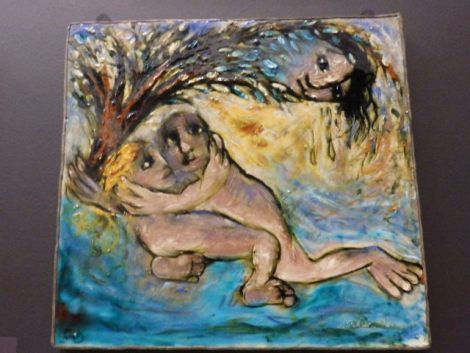
Chagall like isn’t it?
Torrens River
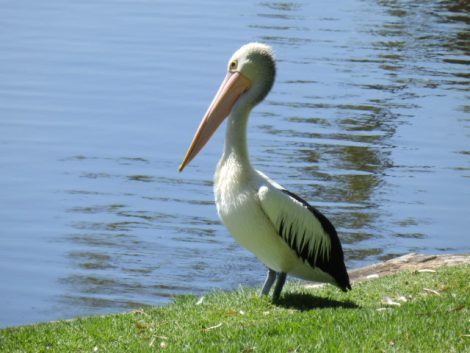
Pelican along Torrens River bank
The small Torrens River borders the North Terrace street and its many historical buildings. The area is a popular city park with footpaths, shade trees, children’s’ playgrounds, and picnic areas.

Is that a yawn or is she showing off?
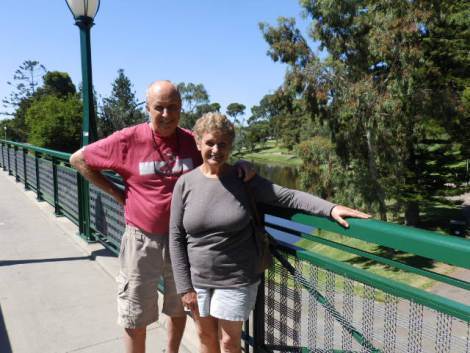
American tourists on Torrens River bridge
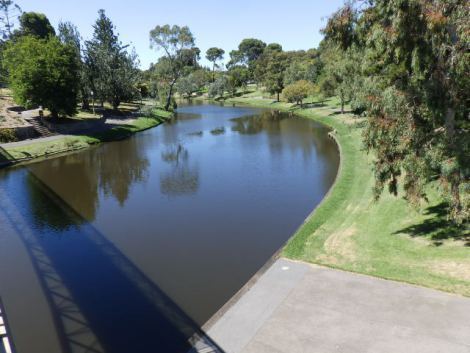
Torrens River behind Government house
Australia Day
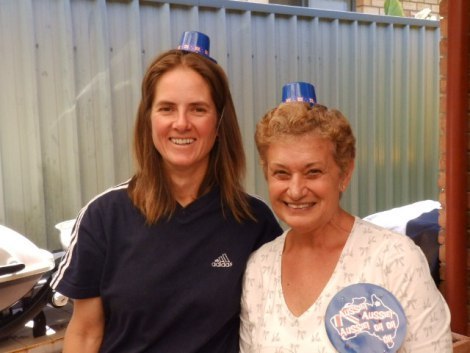
Wendy and Lucy wearing their little Aussie flag caps
We celebrated Australia Day January 26 with our Aussie friends. We spent the day with Wendy, Malcolm and their family, eating the traditional meal of scrambled eggs, beans, bacon, lamb, toast, and salad. Australia Day commemorates the arrival of the British Navy into Sydney harbor on January 26, 1788, when the British flag was raised the first time declaring the territory part of the British Commonwealth.

Traditional Australian Day brunch

Three families on Australia Day
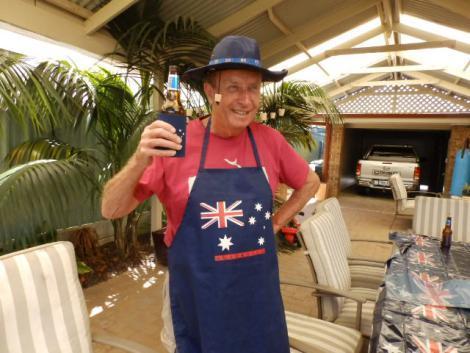
Cheers Mate!
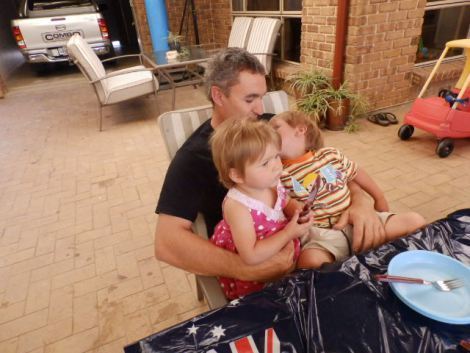
Malcolm, Ethan & Ava
And of course, we had to don some of festive garb that Aussies wear to celebrate their national day. Don’t laugh, we do the same in the US on July 4th, eating barbecue and fried chicken, wearing flag shirts, shorts, Uncle Sam hats while we shoot off fireworks and drink too much beer. The Aussies have the beer thing down pretty well.
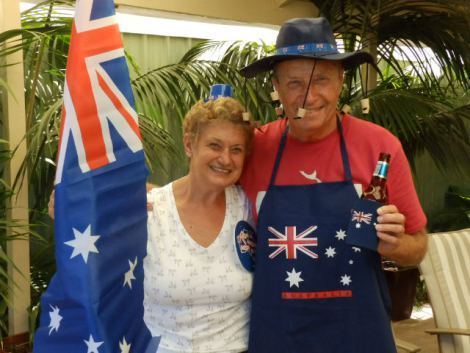
Americans celebrating Australia Day. Silly enough?
* * * * *
Next: Geraldton, West Australia
We’re spending winter Down Under, returning to places we visited in ’12 and visiting new destinations. We look forward to your comments as we travel in Queensland, South Australia, and SW Australia on the Indian Ocean.
As many of you know, I also write mysteries and romantic suspense novels. I recently published my first international thriller, Thirteen Days in Milan, which is available on Kindle as well as other ereaders, tablets, and smartphones. Please share links with writers or readers who might be interested.
http://www.jackerickson.com
Find my books in Apple’s iBookstore
At Barnes & Noble
At Amazon including # 1 Kindle best seller “Perfect Crime”
View my Smashwords profile:


February 13, 2014
‘Roos, Moos, Maggies, & Gums in Adelaide Hills
February 8, 2014
Great Barrier Reef
Diving on the Great Barrier Reef
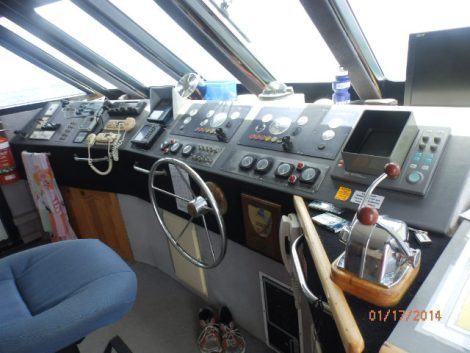
Cabin of our Pro Dive boat
Our first day in Cairns I made arrangements to dive the next week at the Pro Dive shop where I took classes and went on a three-day trip to get PADI certified. The Pro Dive team are very experienced and knowledgeable about all things diving and the many responsibilities of supervising student divers and more experienced divers.
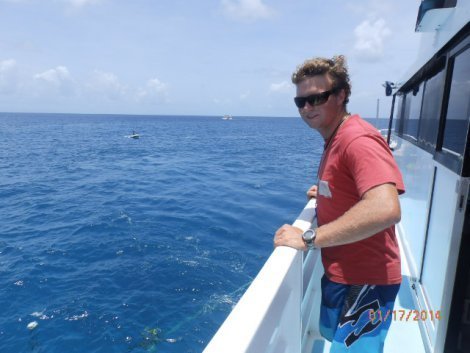
Skipper Sam supervising tying up at Milln Reef
The next Friday, January 17, the weather was cool, overcast, with occasional showers; not the best weather for sailing 52 km to the Great Barrier Reef. But we left the dock at 7 AM, sailing through the shipping channel out onto the Coral Sea. The water was choppy, the sky overcast, with dark clouds on the horizon.
January is the ‘wet’ in northern Queensland when weather can be unpredictable. (The last week in January, cyclone Dylan slammed into Queensland, flooding Townsville and other towns on the coast. Dylan arrived during the ‘king’ tide which is what Aussies call high tide.)
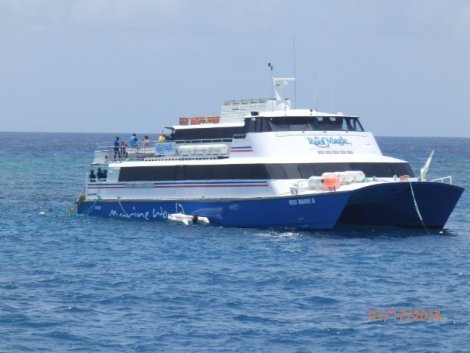
Sister ship of our Prodive boat already on the reef
Aboard our boats were 24 students in three classes of eight who’d taken two days of classroom and pool orientation for PADI certification. They were younger, in 20’s and 30s, from Germany, Denmark, Austria, Switzerland, Australian and even the US. Eight of us were certified and would have 11 dives over the three days, weather permitting.
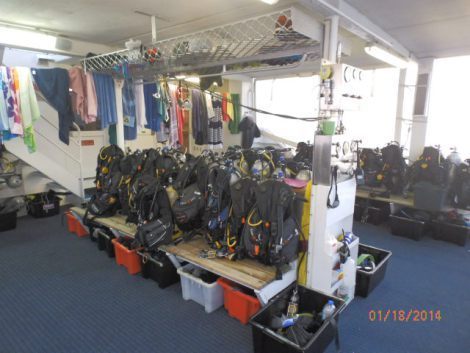
Diving gear ready for our first dive; BCD, tanks, stinger suits, mask and snorkel.
Milln Reef
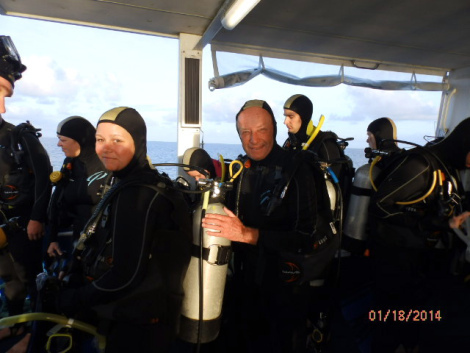
Stinger suits on, gear checked by dive ‘buddy,’ ready to jump off the duckboard into the water.
We dropped anchor about 10:30 AM at Milln Reef where we have dove in ’12. The surface water was still choppy, the wind brisk, and it looked like we might have a storm before the day was out. While students were being briefed about their first dive, our team of eight certified divers entered the water for our first dive.
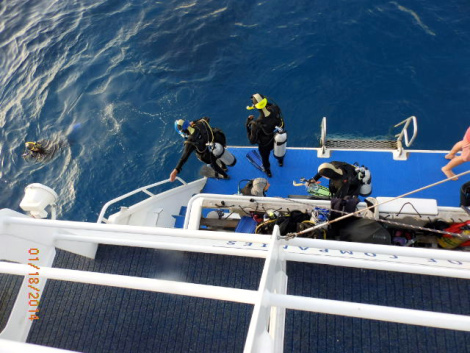
I’m on left with blue mask and snorkel, ready to plunge in.
It was only a 35 minute orientation dive; we had two more dives at Milln before we left later that afternoon for another reef.
After lunch and an hour and half rest, we had dives 2 and 3 with breaks in between. After each dive, the instructor logs your time in the water and the deepest depth of your dive. These calculations determine the time you need to be at the surface for nitrogen that has accumulated in our blood stream to leave.
Night dives
The best dive of the first day was the our night dive at 7:30 PM. During the dive briefing, our instructor handed out glow sticks, plastic tubes the size of a stub pencil with colored chemicals, deep blue, green or pink. Snap the tubes, and the sticks glow. You attached glow sticks to your tank so you can follow other divers; your instructor has two so you know who’s in charge.
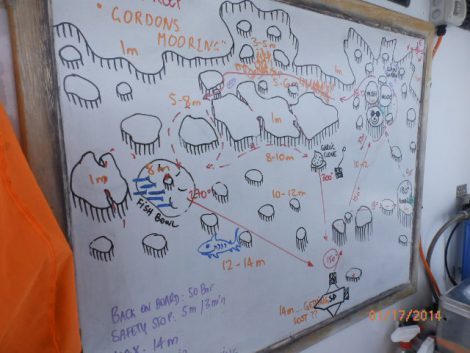
Dive map of first night dive
When we were on the duck board, the dive supervisor handed us waterproof torches, small flashlights with a cord for wrapping around your wrist. Our instructions were to not shine torches at anyones face, and particularly not at eyes of turtles or sharks.
Diving at night is ethereal; you jump into black water, adjust your BCD (buoyancy control device), and as you descend, sweep the bottom with your torch to get oriented. All around, glow sticks and cones of light from the torches are illuminating the dark coral ‘bommies.’ When someone spots something interesting, they wave with their torches so other divers can see eyes of fish hiding in the coral. Fish eyes at night are spots of yellow, red, and orange shining like laser beams. Spooky, but cool.
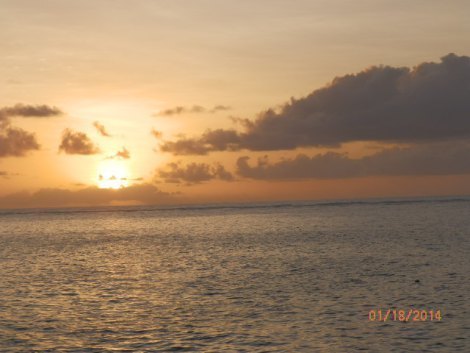
Sunset a half hour before first night dive; weather was clearing
Dive briefings
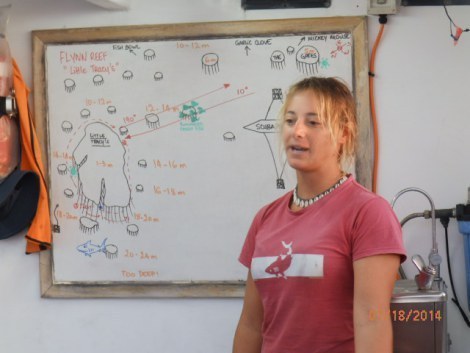
Instructor Chloe briefing on next dive
Before every dive, our instructor briefs us about the area where we would be diving; where coral banks or ‘boomies’ were, the depth to reach them, currents, and compass readings to each area.
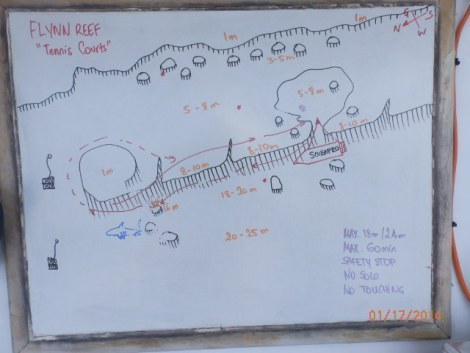
Distance from boat; compass headings, depth, return compass reading, and interesting ‘bommies’ on the way
Divers have dive computers attached to their BCD: a compass; a computer recording current depth, deepest depth, time under, and time at most recent depth; and gauge recording air left in your tank.
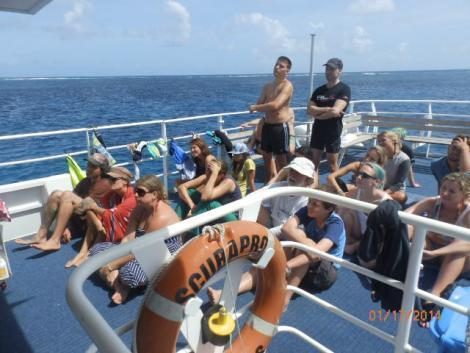
Dive briefing on top deck. Students are now PADI certified.
You start with 200 millibars in your tank; instructors recommend return toward the boat at 120 mb, surface at 70 mb, and board the boat with 50 mb. Each time you board the duckboard, the supervisor records your time under and maximum depth. He/ she has already recorded the time you entered water and time out of water. This security system lets instructors follow the progress of each diver — and make sure no one is left in the water.
Relaxing between dives
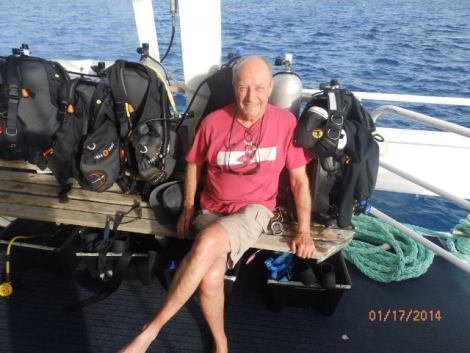
Is it time to put on my wet stinger suit, hook up regulator, strap on BCD and tank, adjust mask and snorkel, check dive buddy’s gear, clean mask, put on fins, and jump off the duckboard? No, not yet.
It’s not all briefings, suiting up for dives, debriefing, getting ready for next dives. Sometimes you just hang around the boat, schmozzing with other divers, hearing their travel stories and backgrounds, and enjoying the incredible experience of being on the reef.
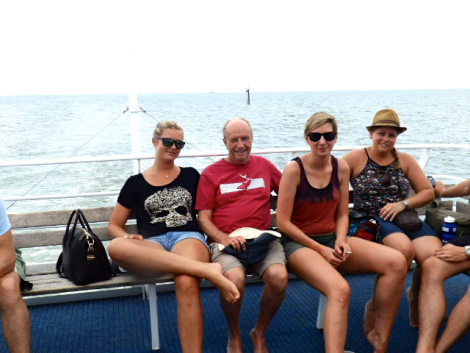
International colleagues from France, Germany, and Austria.
Weilkommen!
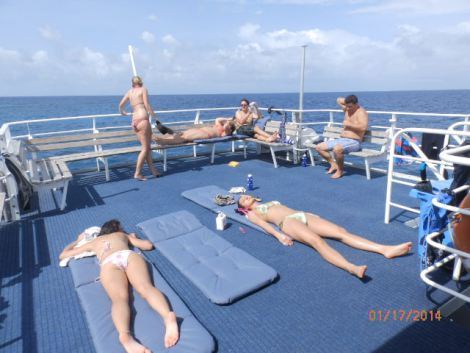
Top deck sunbathing between dives
Chow call!
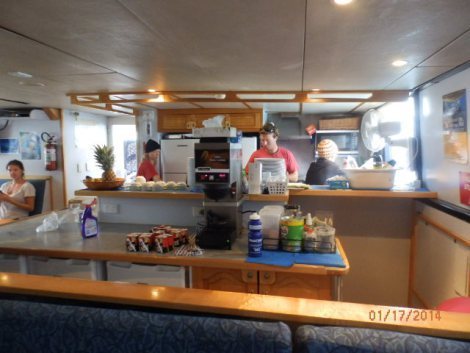
Moments before ‘Chow call!’
[image error]

